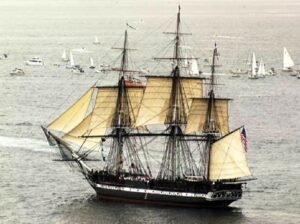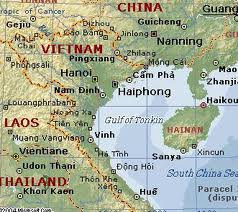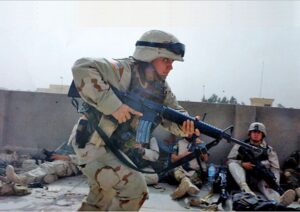USS Constitution
 This myth of maritime warfare has been around a long time. It can be found in numerous places on the Internet and was published verbatim in Navy News some time back. The story (in italics throughout) basically reads:
This myth of maritime warfare has been around a long time. It can be found in numerous places on the Internet and was published verbatim in Navy News some time back. The story (in italics throughout) basically reads:
The USS Constitution (Old Ironsides) as a combat vessel carried 48,600 gallons of fresh water for her crew of 475 officers and men. This was sufficient to last 6 months of sustained operations; she carried no evaporators. On 22 July 1798, the USS Constitution set sail from Boston.
She left with 475 men, 48,600 gallons of water, 7,400 cannon shots, 11,600 pounds of black powder and 79,400 gallons of rum. Her mission – to harass British shipping.
Making Jamaica on 6 October, she took on 826 pounds of flour and 68,300 gallons of rum. Then she headed for the Azores, arriving on 12 November. She provisioned with 550 pounds of beef and 64,300 gallons of Portuguese wine.
On 18 November she set sail for England. In the ensuing days she defeated five British Man of War and captured and scuttled 12 English Merchant ships, salvaging only the rum.
By 27 January, her powder and shot were exhausted. Unarmed, she made a night raid up the Firth of Clyde. Her Raiding Party captured a whiskey distillery and transferred 40,000 gallons aboard by dawn. Then she headed home.
The USS Constitution arrived in Boston on 20 February 1799 with no cannon shot, no food, no rum, no wine, no whiskey and 48,600 gallons of stagnant water.
We might apply some analysis to this.
-o-o-O-o-o-
There was indeed – and still is – a USS CONSTITUTION. She is the world’s oldest commissioned warship afloat, with HMS VICTORY claiming the oldest commissioned warship title, being in a graving dock as opposed to water. CONSTITUTION was launched in 1797 to a successful career, fought well in three wars, and is now homeported in Boston.
To detail the events noted:
The USS Constitution (Old Ironsides) as a combat vessel carried 48,600 gallons of fresh water for her crew of 475 officers and men. This was sufficient to last 6 months of sustained operations; she carried no evaporators.
Well, obviously as far as the evaporators go, unless the Founding Fathers friends were more clever than we know.…48, 600 gallons would give around ½ a gallon a day of water for each ship’s company member over the proposed six-month voyage. However, the water would not have kept that long – in fact water was not drunk in quantity aboard ships, simply because it would not last long enough. For that reason, other beverages which would keep longer were preferred.
The daily ration of liquid other than water for sailors in 1816, records John Winton in Hurrah for the Life of a Sailor, was “half a pint of spirits, or a pint of wine, or a gallon of beer every day”. For the uninitiated, a gallon of beer is eight pints, or very large glasses – the sort served in British pubs – of 500 mls. or about 11 standard glasses of “small beer”; a little lower in alcohol content than the ”heavy” beers of today. That would mean that sailors would be able to get reasonably drunk every day, although the effect of this of course would be tempered by the size of the drinker, and whether he was used to used such consumption and how much he had eaten beforehand. Half a pint of spirits is around 250ml, or perhaps a third of a modern bottle. The USN, derived from the British navy in many respects, also followed the run ration tradition, until its demise on September 1, 1862.
On 22 July 1798, the USS Constitution set sail from Boston.
That is certainly right. The Constitution Museum lists 1798 July 22 as the ship’s “First Sail” However, during the “Quasi-War” with France, she was the Squadron Flagship, from 1799-1801.
She left with 475 men, 48, 600 gallons of water, 7400 cannon shots, 11,600 pounds of black powder and 79,400 gallons of rum. Her mission – to harass British shipping.
If the ship’s company were receiving a daily ration of rum this would be .9 of a gallon of rum a day over six months to get through the lot – and the story implies they did. Perhaps however, the ship was planning an open-ended voyage. Human beings cannot consume .9 of a gallon of spirits a day and survive!
A basic problem with the story overall is that the United States was at peace with Britain between 1783 and 1812, so the ship cannot have entered combat with the British Navy in that time. Now, we can if you like, decide that the story has a simple mistake in the date. So when was Britain at war with the United States and USS Constitution also in commission? Obviously in the war of 1812 – in fact the ship fought three battles with British vessels, and won them all. Perhaps the date has been mixed up. The story indeed can be found with a different date. No less a person than the Secretary of the US Navy, the Honorable John H. Dalton War, repeated the tale recently in 1997, at the Years Reunion Southern Methodist University, Dallas, Texas, on 19 September. He mentioned the year of “1812” however. So, let us continue, and digress to some of the other figures.
CONSTITUTION carried 32 guns of 24lb shot weight, and 20 carronades of 32lb shot weight, plus two 24lb bow chasers.
If each gun fired together, in a double broadside, that is, each gun firing at once, she would expend 64 shot. “7400 cannon shots” would be enough for 115 double broadsides. Just to be fair we might double that, as when a ship fired a broadside it meant the guns on one side firing, and in fact it was apparently difficult to fire both sides’ guns together continually, as there was not enough members of the guns’ crews to do this. A basic gun crew was formed for each gun, and further men were transferred backwards and forwards to the opposing guns as necessary. If we say that CONSTITUTION was carrying enough shot for 230 single-sided broadsides, is that figure accurate? NAM Rodgers tells us in The Wooden Wall that at “…Finisterre in 1747 the DEFIANCE fired forty-two broadsides in an hour and twelve minutes”. Perhaps CONSTITUTION was taking on too much rum and not enough ammunition…
Making Jamaica on 6 October, she took on 826 pounds of flour and 68,300 gallons of rum.
In less than three months, even a very enthusiastic and unrestricted ship’s company could hardly be expected to have gone through that much rum. Was CONSTITUTION planning on selling it or taking it home? However, before we let them escape back to the no doubt thirsty U.S. Navy, we have a problem getting out of the harbor. Jamaica was then a British colony. If the ship’s mission was “to harass British shipping” in 1812, it is doubtful indeed that CONSTITUTION would provision at a British port. Obviously not, as the forces there would attempt her capture. In any event, there would be no reason for her to reprovision after only a few weeks at sea.
Then she headed for the Azores, arriving on 12 November. She provisioned with 550 pounds of beef and 64,300 gallons of Portuguese wine.
On 18 November she set sail for England. In the ensuing days she defeated five British Man of War and captured and scuttled 12 English Merchant ships, salvaging only the rum.
There is absolutely no historical record for any of this. But nevertheless, would not CONSTITUTION have put prize crews on these valuable ships and taken them back to a friendly port, where a prize agent could arrange for their sale to give valuable prize-money to the captors? This was an important motivator in those days. In the war of 1812 between Britain and the United States, one famous action between two ships – the British SHANNON and the U.S. CHESAPEAKE – almost did not commence because of a dispute over prize money:
As the two ships closed for battle, the morale aboard the Chesapeake and the Shannon was in startling contrast. As Lawrence ordered his men to their guns, the crew of the Chesapeake refused to comply. Complaining that they hadn’t received the prize money due them from earlier engagements, they refused to fight unless they were paid. Lawrence quickly ordered the ship’s purser to issue vouchers promising payment to the crew, and only then did they follow orders to man the guns.
Instead of going to Britain as a lone and vulnerable raider, let us see what the USS CONSTITUTION really did. Her war record is readily found and quite straightforward. It may be summed up as:
1812: July 16 – 18. CONSTITUTION escapes a squadron of five British ships by towing and kedging in calm conditions.
1812: Aug. 19. Wins battle against HMS GUERRIERE.
1812: Dec. 29. Wins battle against HMS JAVA.
1813: Overhauled in Boston, but then shut in Boston harbor for eight and a half months by the British blockade.
1814: February-April. Runs the blockade of Boston. Captures the schooner PICTOU and three smaller vessels during cruise to Windward Islands.
1814: Escapes into Marblehead while being chased by two larger British frigates. Returns to Boston for repairs.
1814: Blockaded at Boston for eight months, from April to December. In December 1814: takes advantage of poor weather and escapes.
1815: Feb. 20. Fights British ships CYANE and LEVANT. Captures CYANE; LEVANT surrenders, but British squadron retakes LEVANT.
1815. At war’s end, CONSTITUTION anchored in New York on May 15.
Nevertheless, our story has the ship in different straits.
By 27 January, her powder and shot were exhausted. Unarmed, she made a night raid up the Firth of Clyde. Her Raiding Party captured a whiskey distillery and transferred 40,000 gallons aboard by dawn.
Very interesting. If she put ashore a raiding party of, say, 200 men, each of them would have had to transfer 200 gallons aboard. If this was done, say, at sunset (around 27 January, say 2000 hours?) and the men worked all night for 10 hours straight, they would have had to move 20 gallons an hour each. If each man could carry four gallons at a time, that would still mean five trips an hour aboard the ship. If she was lying off this would be a mighty effort. Still, a very good Scotch or 20 can inspire great feats….
Perhaps the biggest furphy of the whole story however, is to suppose that a party of Americans could make their way into Scotland and capture the Scottish lifeblood. Given the Scots’ attitude to battle, probably all of the Americans would have been met with broadsword and musket and never seen home again.
However, then the ship headed home.
The USS Constitution arrived in Boston on 20 February 1799 with no cannon shot, no food, no rum, no wine, no whiskey and 48,600 gallons of stagnant water.
Again, the date is wrong. But, disregarding that, there is no evidence to suggest CONSTITUTION went out of waters near the United States during the war of 1812. The last phrase is significant in pointing to the illogicality of the whole story – why would the ship have stagnant water on board with all its attendant health problems? Even a ship needing ballast can pump through fresh seawater every few days….
Adding up the gallons of rum we can see that CONSTITUTION apparently went through – because there was none left when she supposedly arrived home – 187, 700 gallons of rum and whiskey in seven months; let us say 210 days. That is 894 gallons a day, or 1.9 gallons per man per day. Disregarding the rum supposedly captured from the supposed British merchantman and the Portuguese wine, a consumption of spirits to this magnitude would have meant that no-one would have been able to make it out of their hammock – let alone weigh the anchor, man the yards, haul on the sheets and all of the other myriad of tasks a wind-powered ship needed performed by human labor. Indeed, a liter of rum a day is enough to lay most people low, and if continued day after day would undoubtedly have resulted in the demise of most of the ship’s company.
Still, never let the truth get in the way of a good story. -o-o-O-o-o-
[Sources: James Pack, Nelson’s Blood | The Story of Naval Rum. Naval Institute Press 1982 | Lt. Tom Lewis, Royal Australian Naval College, Jervis Bay | 16 Aug 2001 ++]


 The Gulf of Tonkin incident is the name given to two separate confrontations involving North Vietnam and the United States in the waters of the Gulf of Tonkin. On August 2, 1964, the destroyer USS Maddox, while performing a signals intelligence patrol as part of DESOTO operations, engaged three North Vietnamese Navy torpedo boats of the 135th Torpedo Squadron. A sea battle resulted, in which the Maddox expended over two hundred and eighty 3-inch and 5-inch shells, and in which four USN F-8 Crusader jet fighter bombers strafed the torpedo boats. One US aircraft was damaged, one 14.5 mm round hit the destroyer, three North Vietnamese torpedo boats were damaged, and four North Vietnamese sailors were killed and six were wounded; there were no U.S. casualties. The second Tonkin Gulf incident was originally claimed by the U.S. National Security Agency to have occurred on 4 AUG, as another sea battle, but instead may have involved “Tonkin Ghosts” (false radar images) and not actual NVN torpedo boat attacks.
The Gulf of Tonkin incident is the name given to two separate confrontations involving North Vietnam and the United States in the waters of the Gulf of Tonkin. On August 2, 1964, the destroyer USS Maddox, while performing a signals intelligence patrol as part of DESOTO operations, engaged three North Vietnamese Navy torpedo boats of the 135th Torpedo Squadron. A sea battle resulted, in which the Maddox expended over two hundred and eighty 3-inch and 5-inch shells, and in which four USN F-8 Crusader jet fighter bombers strafed the torpedo boats. One US aircraft was damaged, one 14.5 mm round hit the destroyer, three North Vietnamese torpedo boats were damaged, and four North Vietnamese sailors were killed and six were wounded; there were no U.S. casualties. The second Tonkin Gulf incident was originally claimed by the U.S. National Security Agency to have occurred on 4 AUG, as another sea battle, but instead may have involved “Tonkin Ghosts” (false radar images) and not actual NVN torpedo boat attacks. Nobody wants to be poor. However, more and more people in the United States are becoming just that – poor. According to US Census Bureau’s data from November 2012, more than 16 percent of American population (or nearly fifty million people) live in poverty. Over the last decade, the number of people who struggled to provide for basic needs such as food, housing, medical care and such was steadily growing (to compare, poverty level was 11.3 percent in 2000, 12.7 percent in 2004, 13.2 percent in 2008, and 15.1 percent in 2010). There are numerous factors which contribute to increasing level of poverty in the USA such as difficult economic climate in the country, high unemployment rates, inadequate access to proper education and job training for many people, growing cost of life, insufficient government assistance, and so on. Still, one would hope that people who are already disadvantaged in many areas of life will at least have the same rights and privileges as their better-off counterparts. Sadly, it is not always the case. One of the most important cornerstones of American democracy is the right to vote. However, in the last few years many states such as Georgia, Indiana, Alabama, Arkansas, Texas, Mississippi, Virginia and others have embraced strict voter ID requirements in order to prevent voting fraud.
Nobody wants to be poor. However, more and more people in the United States are becoming just that – poor. According to US Census Bureau’s data from November 2012, more than 16 percent of American population (or nearly fifty million people) live in poverty. Over the last decade, the number of people who struggled to provide for basic needs such as food, housing, medical care and such was steadily growing (to compare, poverty level was 11.3 percent in 2000, 12.7 percent in 2004, 13.2 percent in 2008, and 15.1 percent in 2010). There are numerous factors which contribute to increasing level of poverty in the USA such as difficult economic climate in the country, high unemployment rates, inadequate access to proper education and job training for many people, growing cost of life, insufficient government assistance, and so on. Still, one would hope that people who are already disadvantaged in many areas of life will at least have the same rights and privileges as their better-off counterparts. Sadly, it is not always the case. One of the most important cornerstones of American democracy is the right to vote. However, in the last few years many states such as Georgia, Indiana, Alabama, Arkansas, Texas, Mississippi, Virginia and others have embraced strict voter ID requirements in order to prevent voting fraud. Voter ID laws require that all voters present government-issued photo IDs at the time of voting, but many critics are concerned that the law might disenfranchise many potential voters, predominantly poor, elderly, and women. According to the study by New York University’s Brennan Center, about 11 percent (or 21 million people) of eligible American voters do not have government-issued photo IDs and do not have necessary means to get them. Moreover, the issue is even worse for elderly (about 18 percent of them do not have current photo IDs) and women (only about 66 percent of voter women have proof of citizenship which matches their current name because many women change their names when they get married). As such, voter ID laws might prevent many people, predominantly poor, from exercising their constitutional right to vote. Among other laws which negatively affect the poor is mandatory testing for drugs if a person is applying for welfare.
Voter ID laws require that all voters present government-issued photo IDs at the time of voting, but many critics are concerned that the law might disenfranchise many potential voters, predominantly poor, elderly, and women. According to the study by New York University’s Brennan Center, about 11 percent (or 21 million people) of eligible American voters do not have government-issued photo IDs and do not have necessary means to get them. Moreover, the issue is even worse for elderly (about 18 percent of them do not have current photo IDs) and women (only about 66 percent of voter women have proof of citizenship which matches their current name because many women change their names when they get married). As such, voter ID laws might prevent many people, predominantly poor, from exercising their constitutional right to vote. Among other laws which negatively affect the poor is mandatory testing for drugs if a person is applying for welfare. Florida has already adopted the law (if a person tests positive, he/she is denied the benefits for one year after which a person can take another test and reapply for benefits), and many other states such as Alabama, Louisiana, Kentucky, and Oklahoma are considering the enforcement of the law as well. However, mandatory drug tests violate Fourth Amendment which restricts what types of searches states can enforce. Moreover, it is evident that this law specifically targets the poor segment of American society. After all, all kinds of people receive government assistance (businessmen, farmers, etc.), but only welfare recipients are required to pass drug tests. The woes of poor do not end here because there are many other laws which target them. For example, many states have laws in place which punish homeless people. According to the data from US Department of Housing and Urban Development, there were about 643 thousand homeless people in the USA in 2009, and as many as 3.5 million people experience homelessness in any given year. However, many states have adopted laws which prohibit activities such as sleeping/camping, eating, sitting, and begging in public spaces and punish the offenders with fines and/or incarceration. Sometimes, these laws veer on the edge of ridiculous as demonstrated by the law in Houston, TX where it is illegal to “molest garbage containers,” thus prohibiting homeless people from looking for food there.
Florida has already adopted the law (if a person tests positive, he/she is denied the benefits for one year after which a person can take another test and reapply for benefits), and many other states such as Alabama, Louisiana, Kentucky, and Oklahoma are considering the enforcement of the law as well. However, mandatory drug tests violate Fourth Amendment which restricts what types of searches states can enforce. Moreover, it is evident that this law specifically targets the poor segment of American society. After all, all kinds of people receive government assistance (businessmen, farmers, etc.), but only welfare recipients are required to pass drug tests. The woes of poor do not end here because there are many other laws which target them. For example, many states have laws in place which punish homeless people. According to the data from US Department of Housing and Urban Development, there were about 643 thousand homeless people in the USA in 2009, and as many as 3.5 million people experience homelessness in any given year. However, many states have adopted laws which prohibit activities such as sleeping/camping, eating, sitting, and begging in public spaces and punish the offenders with fines and/or incarceration. Sometimes, these laws veer on the edge of ridiculous as demonstrated by the law in Houston, TX where it is illegal to “molest garbage containers,” thus prohibiting homeless people from looking for food there. IN THE TINY town of Enterprise, Alabama, there is a statue dedicated to an insect—the boll weevil.
IN THE TINY town of Enterprise, Alabama, there is a statue dedicated to an insect—the boll weevil. These are the times when we are urged to see the big picture, that God IS in everything and everyone, and that something bigger is trying to birth through the challenge/opportunity. Claim the challenge/opportunity as your sign and your herald of PROSPERITY! Then move forward with confidence, knowing that everything is unfolding in Divine Right Order for you’re NEW and BIGGER LIFE. Science of Mindweevil and what it has done as the herald of prosperity. A synonym for herald is assign, a messenger. The leaders recognized that the blight of the boll weevil was simply a messenger that prosperity was on its way.
These are the times when we are urged to see the big picture, that God IS in everything and everyone, and that something bigger is trying to birth through the challenge/opportunity. Claim the challenge/opportunity as your sign and your herald of PROSPERITY! Then move forward with confidence, knowing that everything is unfolding in Divine Right Order for you’re NEW and BIGGER LIFE. Science of Mindweevil and what it has done as the herald of prosperity. A synonym for herald is assign, a messenger. The leaders recognized that the blight of the boll weevil was simply a messenger that prosperity was on its way. In 1945, The Great Writer Aleksandr Solzhenitsyn was arrested by the Soviets for criticizing Joseph Stalin in a letter to a friend. In a special labor camp in Ekibastuz, Kazakhstan, he wrote his epic poem Prussian Nights. He had no pen or paper and was not allowed to write. Each day, he would compose a few lines, carve them into a bar of soap, and recite them over and over again until they were committed to memory. Every evening in his daily shower, he would use the bar of soap and wash away his writing. After years of captivity, he had written the entire book, committed it to memory, and watched it be washed away every evening.
In 1945, The Great Writer Aleksandr Solzhenitsyn was arrested by the Soviets for criticizing Joseph Stalin in a letter to a friend. In a special labor camp in Ekibastuz, Kazakhstan, he wrote his epic poem Prussian Nights. He had no pen or paper and was not allowed to write. Each day, he would compose a few lines, carve them into a bar of soap, and recite them over and over again until they were committed to memory. Every evening in his daily shower, he would use the bar of soap and wash away his writing. After years of captivity, he had written the entire book, committed it to memory, and watched it be washed away every evening. Almost everybody knows a person who has their birthday on some major holiday such as Christmas, Independence Day, New Year’s Eve, or similar. What is it like to have your birthday coincide with one of the universally celebrated events? Do people feel twice as lucky to have everybody around them not only celebrate their birthdays but also a major holiday or do they feel somewhat shorthanded by nature?
Almost everybody knows a person who has their birthday on some major holiday such as Christmas, Independence Day, New Year’s Eve, or similar. What is it like to have your birthday coincide with one of the universally celebrated events? Do people feel twice as lucky to have everybody around them not only celebrate their birthdays but also a major holiday or do they feel somewhat shorthanded by nature? It is undeniable that pets bring something special into our lives. Whether your choice of a pet is conventional (such as cats, dogs, ferrets, hamsters, fish, etc.) or more exotic (snakes, iguanas, tarantulas, monkeys, etc.), there is nothing like a warm feeling we get when we play and communicate with our pets. The number of American households that have pets is rather impressive – according to the Humane Society of the United States, there are 78.2 million dogs and 86.4 million cats owned by people in the country (two most popular kinds of pets).
It is undeniable that pets bring something special into our lives. Whether your choice of a pet is conventional (such as cats, dogs, ferrets, hamsters, fish, etc.) or more exotic (snakes, iguanas, tarantulas, monkeys, etc.), there is nothing like a warm feeling we get when we play and communicate with our pets. The number of American households that have pets is rather impressive – according to the Humane Society of the United States, there are 78.2 million dogs and 86.4 million cats owned by people in the country (two most popular kinds of pets).
 As spring arrives and everything around us starts blooming, not one person can remain untouched by the wonder and beauty of Mother Nature. However, for many unfortunate people spring brings not just enjoyment and happiness but also seasonal allergies. In a nutshell, allergy is an adverse reaction of human immune system to foreign substances (called allergens) which can lead to many symptoms ranging from coughing, sneezing, runny nose and scratchy throat to hives, difficulty breathing, drop in blood pressure, and even anaphylactic death. While people can suffer from different kinds of allergies (food, pets, latex, drug, insects, etc.), seasonal allergy is the most prevalent kind. In fact, as many as 40 million Americans suffer from seasonal allergies; and the number keeps growing due to such factors as climate change and environmental pollution.
As spring arrives and everything around us starts blooming, not one person can remain untouched by the wonder and beauty of Mother Nature. However, for many unfortunate people spring brings not just enjoyment and happiness but also seasonal allergies. In a nutshell, allergy is an adverse reaction of human immune system to foreign substances (called allergens) which can lead to many symptoms ranging from coughing, sneezing, runny nose and scratchy throat to hives, difficulty breathing, drop in blood pressure, and even anaphylactic death. While people can suffer from different kinds of allergies (food, pets, latex, drug, insects, etc.), seasonal allergy is the most prevalent kind. In fact, as many as 40 million Americans suffer from seasonal allergies; and the number keeps growing due to such factors as climate change and environmental pollution. On January 23, 2013 Defense Secretary Leon Panetta announced that the military was going to rescind an official ban on participation of women in direct combat which was put in effect back in 1994. The implementation of this decision would be gradual but is expected to be fully put in place by 2016. Under 1994 ruling, women in military were prevented from direct involvement in front-line combat in artillery, infantry, armor and similar roles. Given the large number of women enlisted in military (according to 2012 statistics provided by the Department of Defense there were 214,098 women in active duty and 118,781 women in reserve), the decision to lift the ban was certainly groundbreaking and incited a lot of discussion regarding the role women play in US military nowadays.
On January 23, 2013 Defense Secretary Leon Panetta announced that the military was going to rescind an official ban on participation of women in direct combat which was put in effect back in 1994. The implementation of this decision would be gradual but is expected to be fully put in place by 2016. Under 1994 ruling, women in military were prevented from direct involvement in front-line combat in artillery, infantry, armor and similar roles. Given the large number of women enlisted in military (according to 2012 statistics provided by the Department of Defense there were 214,098 women in active duty and 118,781 women in reserve), the decision to lift the ban was certainly groundbreaking and incited a lot of discussion regarding the role women play in US military nowadays. Most often, people argue that women, simply because of biology, are not as strong physically as men to endure the hardships of direct combat. Despite the argument of the proponents of the ban that modern war is mostly push-button war and physical strength is not as important as it has been previously, physical strength matters. From carrying heavy loads and running at length it is still undeniable that a person must be physically strong to be an effective soldier. While all soldiers need to pass physical tests, the requirements differ for women and men – and men are expected to perform more strenuous tasks compared to women. In addition, many people maintain that it is important to consider psychological aspects of women being involved in front-line combat. For example, there is a possibility of sexual relationships between male and female soldiers which has the potential of affecting the efficacy and comradely spirit of the unit. Also, many people believe that men will instinctively try to protect their female counterparts and the effectiveness of their military units might be reduced as a result. Moreover, the opponents of the lift of the ban argue that it puts women in very dangerous position because women are more likely to be sexually assaulted and tortured by enemies in case of capture. Some also believe that men will have more difficulties serving under female command which will negatively affect military performance of US army.
Most often, people argue that women, simply because of biology, are not as strong physically as men to endure the hardships of direct combat. Despite the argument of the proponents of the ban that modern war is mostly push-button war and physical strength is not as important as it has been previously, physical strength matters. From carrying heavy loads and running at length it is still undeniable that a person must be physically strong to be an effective soldier. While all soldiers need to pass physical tests, the requirements differ for women and men – and men are expected to perform more strenuous tasks compared to women. In addition, many people maintain that it is important to consider psychological aspects of women being involved in front-line combat. For example, there is a possibility of sexual relationships between male and female soldiers which has the potential of affecting the efficacy and comradely spirit of the unit. Also, many people believe that men will instinctively try to protect their female counterparts and the effectiveness of their military units might be reduced as a result. Moreover, the opponents of the lift of the ban argue that it puts women in very dangerous position because women are more likely to be sexually assaulted and tortured by enemies in case of capture. Some also believe that men will have more difficulties serving under female command which will negatively affect military performance of US army. Will we Truly live again? Instead of fearing death, consider the eternal cycle of life. Death of our earthly body IS simply part of the Perfection of life, for there IS an Essence within each of us that IS the purest form of love and never dies. Rather, it only changes its form. It IS the soul, and we are part of the continuation of the soul’s journey. When we listen to the whisperings of the soul, we are filled with hope and peace.
Will we Truly live again? Instead of fearing death, consider the eternal cycle of life. Death of our earthly body IS simply part of the Perfection of life, for there IS an Essence within each of us that IS the purest form of love and never dies. Rather, it only changes its form. It IS the soul, and we are part of the continuation of the soul’s journey. When we listen to the whisperings of the soul, we are filled with hope and peace. Living a traveler’s life or living a life out of your comfort zone is something that will turn you from that ordinary corporate or from the ordinary house maker, to someone who is a hero or a campfire superstar. But this doesn’t mean, you head straight to your boss’s cabin, and give your resignation. These journeys will test you fully for which you will need some preparation, but at the same time, they will revitalize you, will help you connect with nature and will give you time for introspection and will help you achieve your ultimate nirvana. Therefore, a traveler’s life is much more than just going to places, instead he tends to explore himself while visiting all these places.
Living a traveler’s life or living a life out of your comfort zone is something that will turn you from that ordinary corporate or from the ordinary house maker, to someone who is a hero or a campfire superstar. But this doesn’t mean, you head straight to your boss’s cabin, and give your resignation. These journeys will test you fully for which you will need some preparation, but at the same time, they will revitalize you, will help you connect with nature and will give you time for introspection and will help you achieve your ultimate nirvana. Therefore, a traveler’s life is much more than just going to places, instead he tends to explore himself while visiting all these places.

 Everybody, in today’s world wants happiness and is striving to work for it. But what happens when this happiness is turned into pain or the small, little pleasure of our life become difficult due to the various complexities we create around us? This is to say, what if, the pleasures in which you seek happiness such as aesthetic beauty, being wealthy, success, health, talent etc., turns into pain or, what if, the distinction between pain and pleasure is wiped out?
Everybody, in today’s world wants happiness and is striving to work for it. But what happens when this happiness is turned into pain or the small, little pleasure of our life become difficult due to the various complexities we create around us? This is to say, what if, the pleasures in which you seek happiness such as aesthetic beauty, being wealthy, success, health, talent etc., turns into pain or, what if, the distinction between pain and pleasure is wiped out? “Feelings of inadequacy can plague you sometimes, causing you to feel envious of those blessings that others enjoy. If you spend an inordinate amount of time comparing yourself to the people around you, your ability to appreciate the gifts that are uniquely your own can falter.
“Feelings of inadequacy can plague you sometimes, causing you to feel envious of those blessings that others enjoy. If you spend an inordinate amount of time comparing yourself to the people around you, your ability to appreciate the gifts that are uniquely your own can falter.